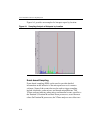
Application Performance Tools A
A-7
The -Qrcd option disables the change to truncation of the rounding
mode in floating-point-to-integer conversions.
For complete details on all of the code optimization options, refer to the
Intel® C++ Compiler User’s Guide.
Interprocedural and Profile-Guided Optimizations
The following are two methods to improve the performance of your
code based on its unique profile and procedural dependencies:
Interprocedural Optimization (IPO)
Use the -Qip option to analyze your code and apply optimizations
between procedures within each source file. Use multifile IPO with
-Qipo to enable the optimizations between procedures in separate
source files.
Profile-Guided Optimization (PGO)
Creates an instrumented program from your source code and special
code from the compiler. Each time this instrumented code is executed,
the compiler generates a dynamic information file. When you compile a
second time, the dynamic information files are merged into a summary
file. Using the profile information in this file, the compiler attempts to
optimize the execution of the most heavily travelled paths in the
program.
Profile-guided optimization is particularly beneficial for the Pentium 4
and Intel Xeon processor family. It greatly enhances the optimization
decisions the compiler makes regarding instruction cache utilization and
memory paging. Also, because PGO uses execution-time information to
guide the optimizations, branch-prediction can be significantly
enhanced by reordering branches and basic blocks to keep the most
commonly used paths in the microarchitecture pipeline, as well as
generating the appropriate branch-hints for the processor.


















